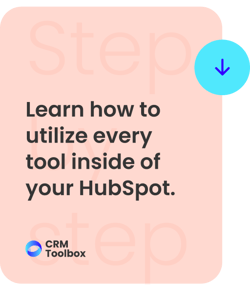Subscribe to ur Blog

One of the most common integrations we work with in CRM Toolbox is the one between HubSpot and Microsoft Dynamics. These are two extremely powerful platforms that, when well aligned, can bring great results.
Although both platforms offer a very complete CRM, both of them have unique features that complement one another. While HubSpot shines for its automation and workflows, Dynamics belongs to a diverse ecosystem, that being Microsoft, which also has an ERP, making it one of the most used tools by medium and large companies.
Why Should You Integrate HubSpot and Dynamics?
Dynamics is most likely the software that the company already has and HubSpot is likely the automation solution that has been proposed to improve the sales cycle. Before moving forward, it is important that you ask yourself if both tools are really necessary for your company and what the goal of having them integrated is.
What we can say is that integrating HubSpot and Dynamics can be one of the best options when your company is looking for even more visibility of the entire process, from the acquisition of prospects by the marketing team to the administration of the human resources that your company has. The goal is to have complete visibility of your users’ purchase journey and how each of the areas in the company has an impact on it.
Benefits:
Close the Sales and Marketing Cycle: If these two areas are not 100% aligned, you are most definitely losing sales opportunities. One of the benefits of a good integration between Dynamics and HubSpot is that the information will be much more reliable since it will travel between areas in a free and structured way. This brings a unified truth to the sales and marketing teams and to the rest of the company, creating a data-driven culture.
Improve Communication with Your Customers: By having both areas aligned, one of the benefits that come with this integration is how the messages you send to your customers will be more consistent, resulting in a better overall experience that generates greater satisfaction, customer confidence, and future repurchase.
You Give a Boost to Both Platforms: The best thing about integrating two tools of this caliber is that they not only complement each other but also increase the scope of one another. This allows you to fully enhance the capabilities of each one and grow your business in an orderly and exponential way.
What You Need To Know
Audit Your Accounts: The first thing you should do is have clear visibility of how the platform you want to integrate is configured. In this case, that would be Dynamics. What kind of objects/entities do you use? If you're using the tool's default objects, then you may be able to integrate using the connector available on the HubSpot marketplace. However, if you're using custom objects, then it's important to work with a specialized partner that can do an integration via API so that the information flows correctly.
Make a Map: No, this is not to get to the treasure, but to the thing closest to it. Mapping your data structure is key to knowing which route you should take during the integration between both platforms. Will the information travel bidirectionally or one way? What will be the source of absolute truth? What data and fields are on each platform and how do they map to one another? What other systems are currently integrated into each of the two tools and how does this integration impact them? What data is currently available? What is necessary? Is there something worth omitting? How is the data currently structured?
This document will guide the integration and serve as a compass to determine how the integration between both platforms will be done.
Do a Data Cleaning: Before integrating anything, you must be sure that you will not be bringing incomplete or incorrect data into the process. Therefore, an essential step is cleaning your data before any integration:
- Eliminate Duplicates: Although it can be a tedious task to perform at the beginning, it will be key for your systems to work optimally in the long term.
- Make Sure the Information is Up to Date: Remove contacts from companies they no longer work for, delete miscaptured contacts, and get rid of anything that could become dead weight once you integrate both platforms.
Define the Objectives Well: If you are going to work with two platforms at the same time, it is important that you know what you will ask each one to do. As I mentioned earlier, some features may be available in both tools, so it is essential to define which tool will perform which action and how this action impacts the other platform. The last thing you want is for two tools to do the same job because it increases the risk of errors and failures.
Shoemaker to His Shoes: A common question is whether or not you should work with two different partners (one specialized in each of the two platforms). Ideally, you should have an expert on each side, because although the companies that are dedicated to making this type of integration know how both works, only a true connoisseur of the platform will be able to provide a complete vision of how everything is configured. Of course, talk to your business partners before and make sure they feel comfortable working as a team with a third party.
Garbage In, Garbage Out: This is quite common with a CRM, so you will have to be very clear about the data that you will take and what will really travel from one place to the other. It may not always be necessary to take 100% of the information from one platform to another. Rather, focus on what is really useful on the other side of the technological spectrum. For example, not all the contacts you have in HubSpot should be reflected in Dynamics. This will only complicate the data and make it more difficult to understand. Ideally, not all contacts should travel to Dynamics. This is one of the greatest advantages of working with two different platforms. In the case of HubSpot, you can create automation to nurture leads and use artificial intelligence to qualify them as they move through the sales funnel. This way, you will only send MQL (Marketing Qualified Leads or Marketing Qualified Prospects) and SQL (Sales Qualified Leads or Sales Qualified Prospects) to Dynamics.
Have an Adoption Plan: Either you choose to integrate all at once and train on the go (not the recommended option) or you have a strategy where some users will be in charge of ensuring that everything works perfectly beforehand. Before making the big roll out with the whole company, it is important that you have a well-defined strategy. You should have all the pieces in place before you start training users because if the tool is not completely stable and users have to spend a lot of time researching how to do things, the chances of failure are much higher.
As you can see, these are two very powerful platforms that, if used correctly, can give your business a great competitive advantage. However, it is important that this is done correctly or you will be dealing with two super motors pulling in opposite directions. Before making the decision to integrate both platforms, you should ask yourself if it is really necessary to work with both.
If you still have questions about how to integrate HubSpot with Microsoft Dynamics or are wondering if it's the right option for your company, then schedule a call with me. I'd love to hear about your project and understand more about the technological challenges that your company faces, so that, together, we can find a solution.
Related Reads
Master HubSpot tools & unleash a world of endless possibilities!
Unlock Your HubSpot Powerhouse: Contact Us to Transform Your Digital Journey!

Ranya Barakat
Ranya is a serial entrepreneur with over 11 years of experience working on the HubSpot CRM. She is a tech geek with a passion for solving problems for customers. She loves pushing her sleeves up , and getting s*** done. When she is not running her Global services team, you can find her upside down on her yoga mat.
Subscribe to our blog
The best information about inbound marketing, sales, guides and migrations.



